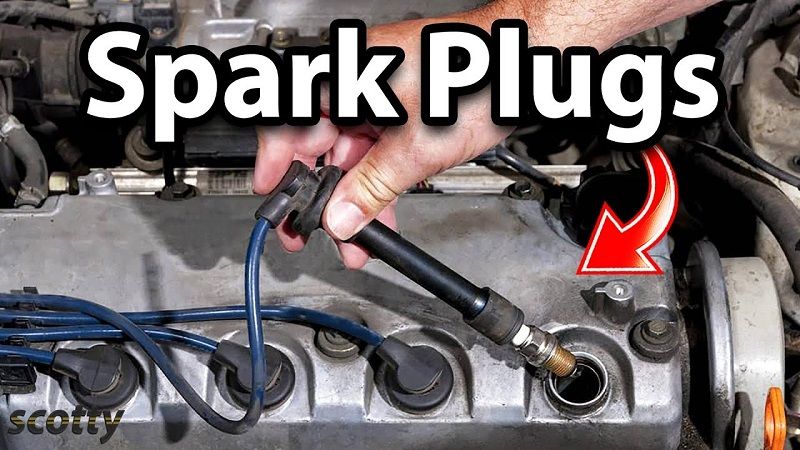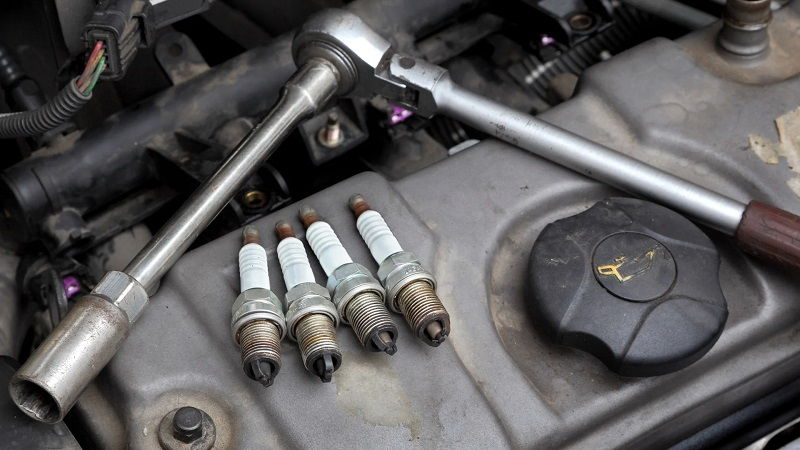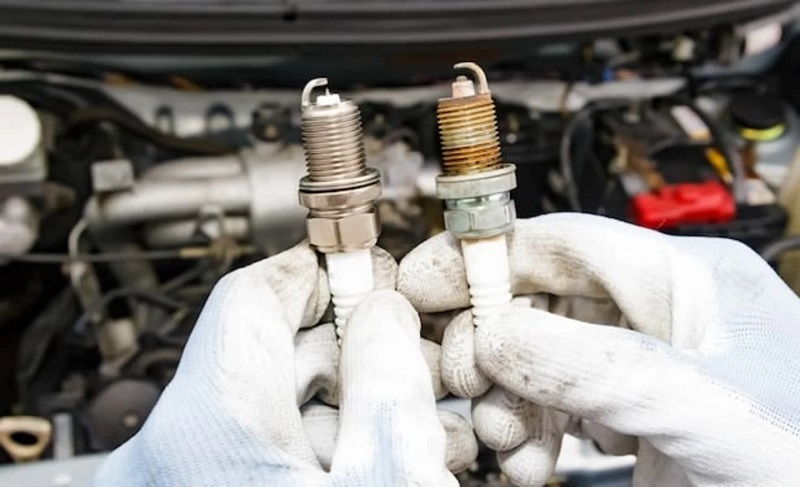This post contains affiliate links. This means I will make a commission at no extra cost to you should you click through and make a purchase [ “As an Amazon Associate, I earn from qualifying purchases.” ]. Read the full disclosure here.
Installing Spark Plugs GuideMechanic.Com When it comes to maintaining your vehicle’s engine, one crucial aspect that should never be overlooked is the proper installation of spark plugs.
Spark plugs play a vital role in igniting the air-fuel mixture inside the combustion chamber, ensuring efficient engine performance and optimum fuel economy.
In this blog article, we will provide you with a detailed and comprehensive guide on how to install spark plugs correctly, ensuring your vehicle runs smoothly and reliably.
Understanding Spark Plugs

Spark plugs are small, but they play a critical role in the operation of your vehicle’s engine. They generate the electrical spark needed to ignite the air-fuel mixture, which in turn powers your vehicle.
There are several types of spark plugs available, including copper, platinum, and iridium. Each type has its own benefits and drawbacks, and it’s essential to choose the right spark plug for your specific vehicle.
The Function of Spark Plugs
Spark plugs are responsible for creating the electrical spark that ignites the air-fuel mixture inside the combustion chamber.
This controlled explosion generates the power needed to move the pistons, which ultimately propels your vehicle forward.
See Also: Honda Civic Spark Plug Replacement: Step-by-Step Guide
Without properly functioning spark plugs, your engine’s performance would suffer, resulting in decreased fuel efficiency and potential engine misfires.
Types of Spark Plugs
Copper spark plugs are the most affordable option and offer good thermal conductivity but have a shorter lifespan. Platinum spark plugs provide excellent durability and performance but may be more expensive.
Iridium spark plugs are the most expensive but offer superior performance and longevity. It’s crucial to consult your vehicle’s manual or a trusted mechanic to determine the best spark plug type for your specific make and model.
Gathering the Necessary Tools

Before you begin the spark plug installation process, it’s essential to gather all the necessary tools to ensure a smooth and efficient procedure. Here’s a list of tools you’ll need:
Socket Wrench Set
A socket wrench set with various socket sizes is essential for removing and installing spark plugs. Make sure you have the correct socket size for your specific spark plugs.
Spark Plug Socket
A spark plug socket has a rubber insert that grips the spark plug securely, preventing damage during removal and installation. It’s specially designed to fit spark plugs and is a must-have tool for this task.
Spark Plug Gap Tool
A spark plug gap tool allows you to measure and adjust the gap between the spark plug’s center and ground electrodes. This ensures the spark plug generates the desired spark for optimal combustion.
Extension Bar
An extension bar is useful for reaching spark plugs located in deep recesses within the engine. It provides additional length to your socket wrench, allowing you to access hard-to-reach spark plugs with ease.
Spark Plug Anti-Seize Compound
An anti-seize compound is applied to the threads of the spark plug before installation. It prevents the spark plug from seizing or getting stuck in the engine, making future removal easier.
Wire Brush
A wire brush is used to clean the area around the spark plug before removal. It helps remove any debris, dirt, or corrosion that may interfere with the successful removal and installation of the spark plug.
Torque Wrench
A torque wrench ensures that you tighten the spark plugs to the manufacturer’s recommended specifications. This prevents over-tightening, which can damage the spark plug or the engine, and under-tightening, which can lead to loose connections and misfires.
Preparing Your Vehicle

Before you dive into the spark plug installation process, it’s important to properly prepare your vehicle to ensure a smooth and efficient procedure. Follow these steps:
Disconnect the Battery
Start by disconnecting the negative terminal of the battery to prevent any electrical current from flowing through the engine. This step minimizes the risk of accidental shocks or electrical damage during the installation process.
Locate the Spark Plugs
Refer to your vehicle’s manual to locate the spark plugs. In most cases, they are located on the engine’s cylinder head and are easily accessible.
See Also: 2010 Ford Fusion Spark Plugs Replacement
However, some vehicles may require the removal of engine covers or other components to gain access to the spark plugs.
Clean the Surrounding Area
Use a wire brush to clean the area around the spark plug. Remove any dirt, debris, or corrosion that may have accumulated over time. This ensures a clean work environment and prevents any unwanted particles from falling into the combustion chamber during spark plug removal.
Removing the Old Spark Plugs
With your vehicle prepared, it’s time to remove the old spark plugs. Follow these steps:
Label the Spark Plug Wires
If your vehicle has spark plug wires, it’s essential to label them before removing them. This ensures that they are reinstalled correctly later on, preventing any misfiring or engine performance issues.
Remove the Spark Plug Wires
Gently twist and pull the spark plug wires to remove them from the spark plugs. Avoid pulling on the wires themselves, as this can damage them. Instead, grip the boot or connector firmly and give it a slight twist while pulling.
Use the Socket Wrench to Loosen the Spark Plugs
Attach the spark plug socket to the socket wrench and carefully insert it over the first spark plug. Apply steady pressure in a counterclockwise direction to loosen the spark plug from its threaded hole. Be cautious not to apply excessive force, as this can damage the spark plug or the engine.
Remove the Spark Plug
Once the spark plug is loose, continue unscrewing it by hand until it can be completely removed. Place the removed spark plug in a safe and clean area, away from any dirt or debris.
Repeat the Process for the Remaining Spark Plugs
Continue the same process for each of the remaining spark plugs, ensuring you keep them organized and labeled accordingly. Take your time and be gentle during this process to avoid any damage or complications.
Inspecting and Cleaning
Now that the old spark plugs are removed, it’s time to inspect their condition and clean them if necessary. Follow these steps:
Inspect the Old Spark Plugs
Examine each removed spark plug carefully for signs of wear, damage, or fouling. Look for any excessive carbon buildup, oil deposits, or electrode erosion. These can indicate underlying issues with your engine or fuel system.
Compare with Manufacturer Specifications
Refer to your vehicle’s manual or consult with a trusted mechanic to ensure that the condition of the old spark plugs aligns with the manufacturer’s specifications. This will help you identify any potential problems or issues that need to be addressed.
Clean the Old Spark Plugs (if necessary)
If the old spark plugs are dirty or have carbon buildup, you can clean them using a wire brush. Gently brush away any debris, being careful not to damage the electrodes or insulator.
See Also: RCJ6Y Cross Reference
Cleaning the spark plugs can help restore their performance temporarily, but it’s important to note that they will eventually need replacement.
Gapping the New Spark Plugs
Before installing the new spark plugs, it’s crucial to ensure that their gaps are correctly set. Follow these steps:
Refer to the Manufacturer’s Specifications
Check your vehicle’s manual or consult with a trusted mechanic to determine the recommended spark plug gap for your specific make and model. This information is crucial to achieve optimal engine performance and combustion.
Measure the Gap
Using a spark plug gap tool, gently insert the tool’s flat edge into the gap between the spark plug’s center and ground electrodes. Gently twist the tool to widen or narrow the gap until it matches the manufacturer’s recommended specification.
Double-Check the Gap
After adjusting the spark plug gap, use the gap tool again to ensure it matches the recommended specification precisely. A correctly gapped spark plug will ensure proper ignition and combustion within the engine.
Installing the New Spark Plugs
With the new spark plugs properly gapped, it’s time to install them into your engine. Follow these steps:
Apply Anti-Seize Compound
Using a small amount of spark plug anti-seize compound, apply a thin coating to the threads of the new spark plug. This compound prevents the spark plug from seizing or getting stuck in the engine, making future removal easier.
Thread the Spark Plug by Hand
Take the first new spark plug and carefully thread it by hand into the spark plug hole. Make sure the spark plug is aligned properly to avoid cross-threading, which can damage the threads in the engine. Turn the spark plug clockwise until it is snugly seated.
Tighten the Spark Plug with a Torque Wrench
Using a torque wrench, apply the manufacturer’s recommended torque specification to tighten the spark plug. This ensures that the spark plug is securelyfastened without over-tightening.
Over-tightening can lead to damage to the spark plug or the engine, while under-tightening can result in loose connections and potential misfires. Follow the torque specifications carefully to achieve the desired tightness.
Repeat the Process for the Remaining Spark Plugs
Continue the same process for each of the remaining new spark plugs, ensuring that you apply the appropriate amount of anti-seize compound and tighten them to the recommended torque specifications. Take your time and double-check your work to ensure all the spark plugs are securely installed.
Reassembling Your Vehicle
With the new spark plugs installed, it’s time to reassemble your vehicle. Follow these steps:
Reconnect the Spark Plug Wires
Take the labeled spark plug wires and reconnect them to their respective spark plugs. Ensure each wire is securely attached, making a firm connection. Take care not to mix up the order or connect them to the wrong spark plugs, as this can lead to engine misfires.
Reattach Any Removed Components
If you had to remove any engine covers or components to access the spark plugs, now is the time to reattach them. Follow the reverse order of removal, ensuring all parts fit snugly and securely. Check for any loose connections or fasteners before proceeding.
Reconnect the Battery
Finally, reconnect the negative terminal of the battery that you had previously disconnected. Ensure a tight and secure connection, and double-check that all other electrical connections are intact and properly seated.
Testing and Troubleshooting
Now that your vehicle is reassembled and the new spark plugs are installed, it’s essential to test their functionality and troubleshoot any potential issues. Follow these steps:
Start the Engine
Crank the engine and start your vehicle. Pay attention to the engine’s sound and behavior during startup. A properly installed and functioning spark plug will contribute to a smooth and consistent engine start.
Monitor Engine Performance
While the engine is running, observe the vehicle’s performance. Listen for any abnormal noises, vibrations, or hesitation. A properly installed spark plug will contribute to efficient combustion and smooth engine operation.
Check for Misfires
If you notice any engine misfires, such as rough idling or hesitation during acceleration, it could indicate an issue with the spark plugs. Use a diagnostic tool or consult a mechanic to identify the specific cylinder or cylinders experiencing misfires.
Addressing Misfires
If you experience engine misfires, it’s important to troubleshoot and address the issue promptly. Check the spark plug connections, ensure they are properly tightened, and confirm that the spark plug wires are correctly attached.
See Also: Subaru Forester Spark Plug Replacement Cost
If the problem persists, it may indicate a deeper underlying issue that requires further investigation by a qualified mechanic.
Maintaining Spark Plug Health
Installing new spark plugs is just the beginning of ensuring optimal engine performance. Proper maintenance is crucial to keep your spark plugs in excellent condition. Follow these tips:
Follow the Manufacturer’s Maintenance Schedule
Refer to your vehicle’s manual and follow the manufacturer’s recommended maintenance schedule for spark plug replacement. Regularly inspect and replace your spark plugs according to the specified intervals to prevent any potential performance issues.
Monitor Fuel Quality
Poor fuel quality can lead to spark plug fouling or damage. Ensure you use high-quality fuel from reputable sources to minimize the risk of fuel-related issues affecting your spark plugs.
Keep the Engine Clean
Regularly clean your engine to prevent dirt, debris, and contaminants from accumulating around the spark plugs.
Use compressed air or a soft brush to remove any loose particles, ensuring they don’t interfere with the spark plug’s operation.
Inspect Spark Plug Wires
Periodically inspect the condition of your spark plug wires. Look for any signs of wear, cracking, or damage.
Damaged spark plug wires can lead to inefficient spark delivery and potential misfires. Replace any worn or damaged wires promptly.
Perform Regular Tune-Ups
In addition to spark plug maintenance, regular tune-ups can help ensure overall engine health. This includes checking and replacing other components such as air filters, fuel filters, and ignition coils, which can impact spark plug performance.
Consult a Professional Mechanic
If you’re unsure about any aspect of spark plug installation or maintenance, or if you encounter persistent issues with your vehicle’s performance, it’s always wise to consult with a professional mechanic. They can provide expert advice, diagnosis, and assistance tailored to your specific vehicle.
In conclusion, properly installing spark plugs is a critical aspect of maintaining a healthy and efficient engine.
By following our detailed and comprehensive guide, you can ensure a successful spark plug installation that will contribute to improved fuel economy, reliable ignition, and overall performance.
Remember to take your time, follow the manufacturer’s guidelines, and perform regular maintenance to keep your spark plugs in optimal condition. With these steps, you’ll be well on your way to enjoying a smooth and trouble-free driving experience.
Related video of Installing Spark Plugs: A Comprehensive Guide for Efficient Engine Performance
- How to Use Catalytic Converter Cleaner - April 16, 2025
- Dura Lube Catalytic Converter Cleaner: Does It Work? - April 15, 2025
- Does Catalytic Converter Cleaner Work? - April 13, 2025
